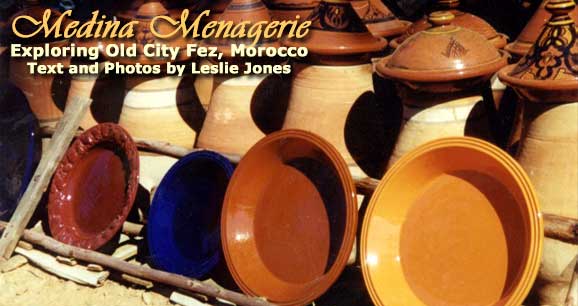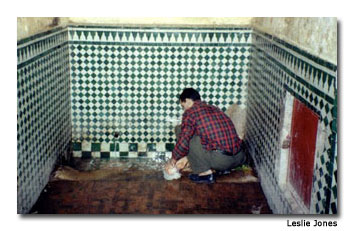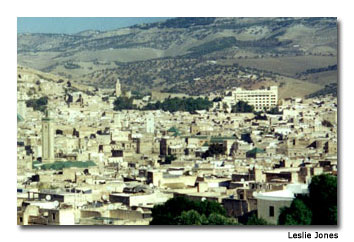

Exploring the City
I barely escape being run over by ducking into the nearest doorway, as donkeys carrying heavy loads crowd into the long, narrow corridor.
With shouts of “Balak! Balak!” (look out!) announcing the animals’ arrival, vendors, residents, tourists and children step out of the way as livestock spill into the dark passages within this mysterious labyrinth.
As soon as the donkeys pass, the swarm of humanity closes in again, everyone carrying on with their daily lives.
The world within the ancient walls of Fez, Morocco, offers myriad sights and sounds for those who enter.
No description can serve justice to the deluge of shouts of bartering and swirls of vibrant colors here, an almost unconceivable panorama that has barely changed in the past thousand years.
Fez, founded in the 9th century and home to the oldest university in the world, is one of the best-preserved medieval cities of the Arab-Islamic world, and is a UNESCO World Heritage Site.
While still learning to manipulate the uneven cobblestones underfoot, I slowly regain my composure and begin to explore the souk’s passages with trinkets of all shapes and sizes.
Delicious Dishes
Fresh fish and meats, leather goods, vegetables and fruits, earth-toned spices, caged pigeons, and copper pots and pans are all intermingled within this city of goods.
The Hand of Fatima, a sacred design that offers safety and a watchful eye over people, is artfully crafted into silver key chains, earrings and pendants.
Perhaps it’s a good idea to buy something to better ensure my imminent safety.
An elderly man sits in the corner of one copper kitchenware shop, sharing his craftsman techniques with a young boy.
Perhaps it’s his grandson being trained to carry on the family business into the next generation. How many generations have come before him?

Beggars kneel with outstretched hands while sharply dressed businessmen in hooded burnooses respectfully walk around them to congregate at community water wells.
Women walk, eyes lowered to the ground, beautifully adorned in their colorful djellabas, shopping for the daily produce.
Cats, obviously unintimidated by this cacophony, stare up at the fish counters, hoping for a scrap or two for a midday meal.
Cumin, ginger, fava beans and paprika are colorfully displayed in small stands lining bustling passages, alongside olives, nuts, mint and saffron.
While skilled artisans form copper cooking pots over open fires, the mouth-watering aroma of freshly baked herb bread wafts in the air. I suddenly realize that I’m famished.
A merchant hands our guide several rounds of bread while they chat. The fresh, warm bread tastes of delicate herbs and spices, like everything I’ve tasted here in Morocco.
Another round is passed and our group moves on through this mesmerizing dream.
Our guide confidently leads his flock, like lost sheep, herded in a single-file line. He warns us repeatedly that if lost, it will take days to be located.
He doesn’t appear to be a friendly man, and he seems somewhat pompous, but here today, we must trust him.
A steep, narrow stairway leads to a shop filled with colorful leather goods. I purchase a pair of leather babouches (slipper-like shoes) in bright saffron, a color I will forever associate with Morocco.
We are guided up a staircase onto a terrace several stories about the street, where skilled tanners are crouching and balancing over enormous vats filled with dyes in shades of bright saffron, poppy, indigo and black.
The Magnificent Leather Goods of Morocco
This area is where some of Morocco’s magnificent, world-renowned leather goods are colorfully adorned.
A fellow traveler, eager to visit the leather merchandise one story higher, vanishes, escaping the guide’s watchful eye.
Suddenly aware of her absence, he quickly dashes after her. Scolding her on the way down to the busy streets below, he again reminds us all of the danger lurking within these walls.

The guides’ harsh words have fallen deaf on the ears of those of us with the greatest curiosity.
As we proceed down the guide’s chosen path, I evasively move to the back of the line, walking a bit slower, to peer into the many intriguing doorways.
As I catch brief glimpses of ornately tiled courtyards, I long to wander through one of the stylishly decorated residences.
Kairouyine Mosque
Gated residences, mosques and palaces here are private, with courtyards open to the heavens. Filled with fountains and trees, they serve as reminders of nature and of Allah’s bountiful blessings.
Allah’s blessings are recounted daily at the nearby venerable Kairouyine Mosque, one of the oldest and largest mosques in Africa, situated at the heart of the medina.
The spectacularly ornamented building was erected in 810. The associated university was founded in 859.
As we are herded around another corner and up a little hill, we encounter a berber rug shop, filled with colorful designs. We are seated and sugary sweet mint tea is served while a rug purchasing “show” begins.
Several individuals are suddenly selected from the group and led to a room far above, to be shown more samples.
As quickly as I’m herded upstairs, I sneak back down; I’m not buying their selling schemes. While several in the group purchase rugs, I again venture outside.
Bright silk fabrics flap in the breeze, a henna artist paints designs on a young woman’s feet, and a small cafe serves harira soup (made of beans, lentils and cilantro) and lamb in beautifully crafted blue-and-green earthenware bowls.
I had admired this colorful, extraordinarily crafted pottery earlier in roadside stands throughout Morocco.
At the end of our tour, we pass through a gate, suddenly leaving behind the sights and smells of the souk.
After I thank our guide with the traditional greeting “chakran!” and press a fewdurhams into his hand, my mind continues to wander within those walls for the remainder of the afternoon.
Old City Walls
As I glance one last time over my shoulder at the old city walls, I notice, for the first time, an abundance of television antennas on many rooftops.
Many thousands of people live within these walls, with no extra room to breathe and no additional housing available. What to me has been an exotic visit is merely everyday life to its inhabitants.
While some in our group are thankful to see this highly sensory experience end, others are ready to reenter and spend a few extra hours reliving everything we have witnessed.
As for me, I can’t help feeling as though I’ve been inducted into a secret society.
If You Go
Morocco Travel Guide
www.morocco.com
- What is Altitude Sickness and How Can You Avoid it? - June 18, 2025
- Cinnamon Bay Campgrounds, U.S. Virgin Islands - January 10, 2021
- Colorful Colonia del Sacramento, Uruguay - January 9, 2021
